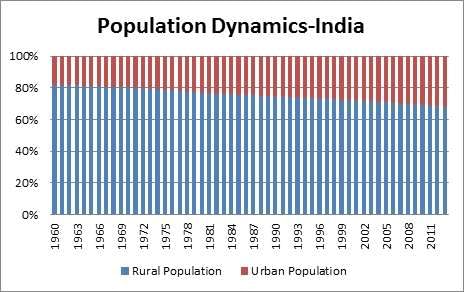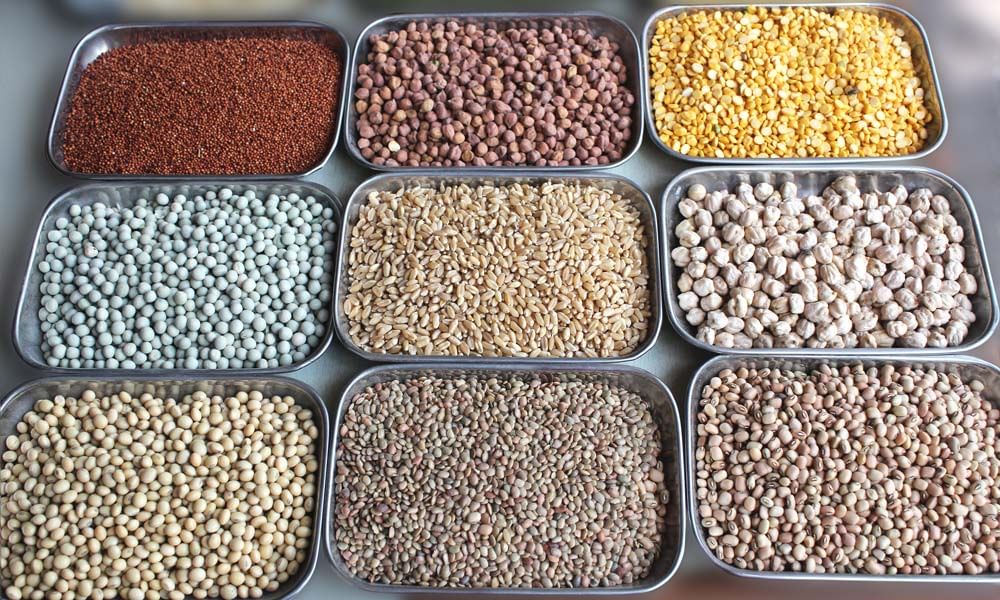How Intelligent Entrepreneurship Can Transform Rural India
In a developing nation like India, Sadhguru says, any enterprising person can find possibilities in what others view as obstacles. He describes many of the obstacles currently faced by rural populations of the country and details how today’s bold and brainy entrepreneurs can invest in engineering a prosperous transformation.

But otherwise, if you have the brains and the guts to do something, there is so much to be done in the world, and especially in a country like India. If you are enterprising, the world cannot stop you.
The world may put obstacles in your way. Either you can see them as obstacles or as possibilities. Where there is a problem, if you look for the solution to the problem, there will be a great possibility. And there are lots of problems in our country. We should invest in solving them.
Fixing The Farmer’s Plight

When we think about the economy, we tend to think of the stock market or financial centers like Mumbai. But sixty-five percent of India’s population lives in rural areas. Most of these people have had an absolutely bad deal in the last eight to ten generations. If you walk into a village today, most men do not even have a fully developed skeletal system. The women are in a much worse condition.
What is needed is the urbanization of rural India, and that will remain a dream unless agricultural income multiplies in the next few years. Over half our population is involved in agriculture. If we just double their income, our economy will go through the roof. Only if we transform this sector into a very lucrative activity, can we hope to hold the population in rural India. Otherwise, they will naturally migrate to cities, which will lead to a huge amount of civil unrest. We are already seeing this to a certain extent in our cities today.
There are two major problems destroying our farmers and driving them to poverty and death: investments in irrigation and a lack of negotiating power in the market. The way agriculture is done right now is that each farmer has his own pump set, his own borewell and electrical connection. The kind of investment this requires is so high that debt is inevitable, and the farmer either has to sell his land, run away from his village or hang from a tree. And after all this, when the farmer wants to sell his produce, there is no transport, storage or even an established market. Growing a crop is one thing, but taking it to the market is a big circus for the farmer.
We are looking at how to change this by bringing farmers together into Farmer-Producer Organizations (FPO) with a minimum of 10,000 acres of land. We are working out legal structures to ensure that farmers retain control over their land and it is one hundred percent safe for them. Farmers can cultivate their land individually, but micro-irrigation and marketing of produce can be taken care of for them, together, by companies that have the necessary competence. If we create this support for our farmers, so that they do not have to bother about anything other than growing food, India can become the breadbasket of the world. If you add in the income from value-added products, milk, fisheries and crafts, this can be a tremendous growth story in rural India.
Reviving Traditional Medicine
Another very lucrative agricultural area is with medicinal plants. At Isha, we use siddha medicine very effectively, but on a small scale. The problem we have found with both siddha medicine and, to a lesser extent, with ayurveda, is that the ingredients which go into it need to be of a certain quality, which is very difficult to manage.
Subscribe
If you pluck something from a tree, its quality will be different depending on whether you pluck it in the morning versus the evening, in the summer or after rain. Siddha vaidyas – those who practice siddha medicine – are conscious of these things, but they are not able to maintain it.
We have been experimenting for over twenty years to increase the scale. But if you stretch the scale, the effectiveness goes down. This is a big challenge. This is where modern medicine or allopathy becomes very effective, because they are just chemicals: you can produce any amount of tablets. But siddha medicine is not like that. It is very organic, and there is an elemental part to it which requires a certain level of expertise for people to be able to use it. This requires a lot of involvement and application, not just a five-year medical degree. You need to understand these things experientially.
Procuring ingredients has also become very difficult. At the Isha Yoga Center, because we live right next to a fantastic mountain, we have the privilege of having access to certain things. But if we try to move these raw materials to the United States where we have a clinic, we have to either desiccate, preserve or refrigerate it. Then it does not have the same impact and quality.
This is something most people will not admit, but for any ayurvedic medicine, no matter what company it is from, the variation in effectiveness from batch to batch can be enormous because of these reasons. Maintaining batch quality in ayurvedic medicine, and particularly in siddha medicine, is nearly impossible because nobody can control in what condition this particular leaf is when you pluck it. Even if you take enormous care, one batch is fantastic, another batch is down there, another batch is somewhere in between. This is the problem with traditional medicines. Only when it is fresh and right there, it works in a fantastic way.
When the land was rich with a lot of herbs and everything was available, then traditional medicine prospered. But now, you have to go to one particular hill to get this. So it is not working the same way when you try to scale it up.
The only way to bring back ayurveda and siddha in an effective way is if agricultural entrepreneurs are willing to setup a place where they grow medicinal plants in the right kind of quality, in an organic manner. Not only can this be a very profitable venture, this will also bring traditional medicine back as an effective process.
The Power of Natural Seed
One of the most idiotic things we have done as a nation is that instead of corporatizing irrigation and marketing, we corporatized seed and fertilizer, and now we import our seed from outside the country. Do not underestimate the power of being able to produce our own food. It is a tremendous power. But we may lose it because all our seed is coming from outside.
In Southern India, particularly certain parts of Andhra Pradesh, Karnataka and Tamil Nadu, there is a history of farming for over twelve thousand years. For these twelve thousand years, we farmed the same land, probably some of them were the same families, and for the last several thousand years we have been using the same seed.
The power of holding our own seed in our hand was a tremendous one. In Karnataka this was known as Beeja Devaru. In every home, there were a few sacks of seed in one corner that we worshipped every day. This seed was not used even if we were hungry. They were used only after the rain for sowing. But we lost this in the last 35-40 years, and we are going to pay a huge price for this.

Most of the cereals that this nation had are gone. I was told that in the last fifty years, more than some eighty-seven varieties of pulses, grains, legumes and cereals have been lost for good. If you walked into a shop just thirty years ago in South India, there would be so many kinds of dhals and lentils. Now everyone is just eating white rice and wheat, nothing else is left.
This was not the way in the past. At different times of the year, we ate different kinds of cereals, which kept us healthy and well. Today, after spending millions of dollars on research, they are telling us that is the way to eat. That is how we have been eating for thousands of years, but we lost it in the last thirty years.
Unfortunately, we have not only raped the land, we have taken away the natural seed which did not just take sustenance from the land, but also nurtured the land. This is the important thing about the indigenous seed. If you bring some strange species and plant it here, a big disaster will happen.
The people of Karnataka have seen this. The silver oak and eucalyptus trees only took sustenance from the land, but did not nurture the soil. If you walk into a eucalyptus plantation and see how the land is, not even insects are there because even they do not want to be there. If the worms and insects do not like it, that means you are done.
We are doing all these things because of certain very short term benefits that somebody else is getting. These things have to be properly handled, otherwise everything that’s valuable to us will be gone.
Bringing back natural seed is very important. It will be far more beneficial and healthier, and will be exportable because everywhere in the world, people are looking for indigenously grown organic substance today.
From Filth To Wealth
Another big role that entrepreneurs can play is in transforming filth into wealth. Right now, most of the sewage in our towns and cities is dumped in our rivers and ocean. This is not only a big pollution hazard, it is also a huge economic loss because there are many technologies today that can turn filth to wealth. Singapore has demonstrated this by turning their wastewater into drinking water. We needn’t go for that level of purification, but for example, if we just use the 36 billion litres of sewage from India’s cities and towns, we can micro-irrigate 6 to 9 million hectares.
There is so much business out there in the filth. For example, people talk about how plastic is bad. But that’s not correct because plastic is one of the most recyclable materials. It is the material of the future if we use it right. The problem is not plastic. The problem is irresponsible usage of plastic.
Instead of just throwing it around, we need to see how plastic recycling can happen. This need not be done as a centralized industry. It can happen at the local level itself and become an economic opportunity for the rural populations. If they see that this filth is actually wealth, they won’t leave a piece of plastic anywhere. They will take care that it all goes back into recycling.
Transforming Rural India
Today, India is sitting on the threshold of prosperity. If we do the right things in the next ten years, we can move this huge mass of people from one level of living to another. The corporate sector has the responsibility and privilege of using its expertise and capabilities to engineer this transformation. This is not charity. This is an investment with very substantial returns, both financially and in terms of providing millions of human beings with a life of dignity and prosperity.
Editor's Note: Here's a rare chance to imbibe and explore the science of scaling up your business at "INSIGHT, the DNA of Success" - an annual, 4-day business leadership intensive program. This year's program includes key resource leaders such as Kishore Biyani, Founder and Group CEO of Future Group; Bhavish Aggarwal, Co-founder and CEO of Ola Cabs; and Amitabh Kant, CEO of NITI Aayog. Don't miss the opportunity! Register for the INSIGHT 2018 program.



